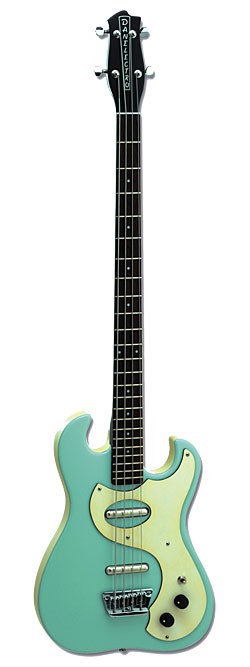
Danelectro Dano ’63 long-scale bass in Aqua. Photos courtesy of Evets.
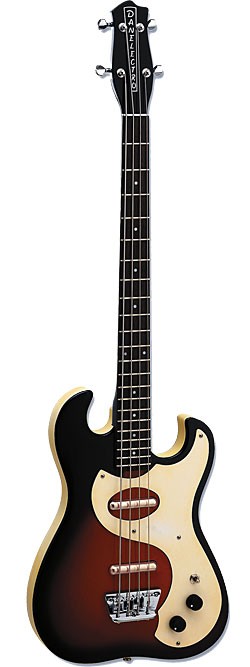
Danelectro Dano ’63 short-scale bass in Red Burst. Photos courtesy of Evets.
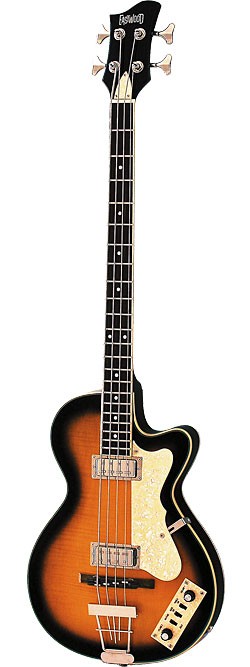
Eastwood Club Bass in Sunburst. Photos courtesy of Eastwood.
As with fashion, cars, motorcycles, music, and many other elements of current pop culture, today’s electric bass market is chock full of instruments designed to look, sound, and play like classics from decades past.
Perhaps more than that, though, these basses appeal to the nostalgic side of anyone who followed music, even casually, in decades past, or has since acquired an appreciation for that music. Babyboomers might wistfully recall their strange silhouettes, while younger players think they’re simply cool and different.
Are they “reissues?” Maybe, maybe not. But some are accurate reproductions of the originals, often refined in terms of hardware or construction. One example is the Ampeg Plexiglas bass, which was initially made from 1969 through ’71. It certainly has a following amongst players and collectors, but the modern version offers a vastly improved bridge.
Other retro basses may not have had an exact progenitor, but can be classified in one of several ways. There’s a) the contemporary bass that references (but doesn’t exactly copy) an original model; b) the bass that looks like something from the 1950s or ’60s, even if no such instrument was made then, and; c) a bass that references an original and has unique features found on other guitars or basses.
A number of brands and models today are exploiting the “time warp” factor, and they are as diverse and fascinating as the originals. True, nearly all are imported; but it’s also true their materials and build quality are superior to the original.
Danelectro
In the ’50s and ’60s, many aspiring guitarists and bassists began their musical sojourn with inexpensive Masonite-over-wood-frame instruments that had pickups made from lipstick tubes. More often than not, these bore the Silvertone brand name (which was sold by catalog retailer Sears) on their headstocks, but were made by the Danelectro company of New Jersey.
Fans of these entry-level classics had reason to rejoice in 1996, when the Evets Corporation purchased the Danelectro name and began making new instruments based on classic “Dano” models. Their first guitar was marketed in ’98, and first bass (the 58 Longhorn) debuted in ’99. The 58 Longhorn was a fairly accurate copy of its short-scale progenitor, with improvements such as an adjustable truss rod and an improved bridge/tailpiece.
“The very first Danelectro reissues we introduced were pretty much dead-on with the originals,” recalled Evets president Steve Ridinger. “Non-adjustable rosewood saddle bridge, stacked pots… The tuners were enclosed, but were only marginally better than the originals.”
The company quickly diversified and improved the quality of specific parts. Basses introduced in the ensuing years included a long-scale Shorthorn bass (the original was short-scale), and Mosrite-shaped instruments such as the Hodad and Rumor, the latter being a solidbody guitar with built-in effects. More recently, Danelectro has taken to offering models for a limited time before moving to another.
“The first thing we had to learn is that we aren’t Fender!” he explained. “We’re a niche brand known for tone, coolness, and affordability. It doesn’t make sense to make 50 models and expect dealers to hang all of them on the walls. So we now make one model per year, discontinue it, then offer a new model.”
The newest incarnation is the Dano ’63 series, based on the early-’60s two-pickup Silvertone 1457L. Sears didn’t market a corresponding bass, so the new basses and baritone guitar are definitive of something that gives only a cosmetic tip of the hat to the past.
All Dano ’63 instruments – guitars, basses, and baritones – use the same body, with pressboard/Masonite-style top and back over a plywood frame. Ridinger says the plywood frame offers better tone than pine or poplar frames, which his company had tested. The necks are made from Canadian maple, the nut is aluminum, and the much-improved bridge offers individual string intonation.
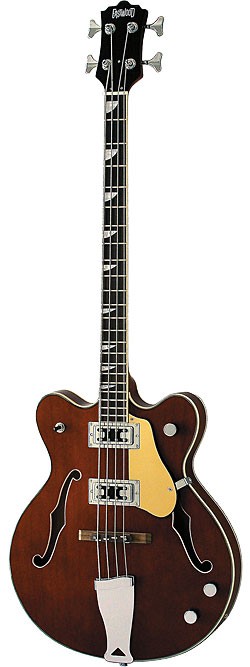
Eastwood Classic 4 in Walnut. Photos courtesy of Eastwood.
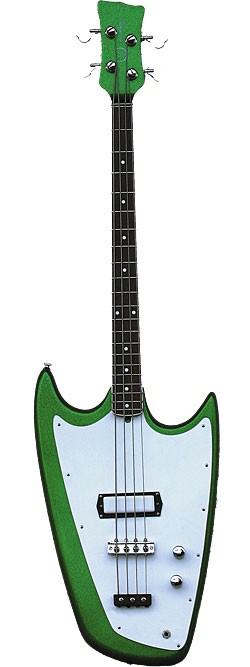
Hallmark Vintage Series Swept-Wing in Alien Sparkle Green. Photo by Willie G. Moseley.
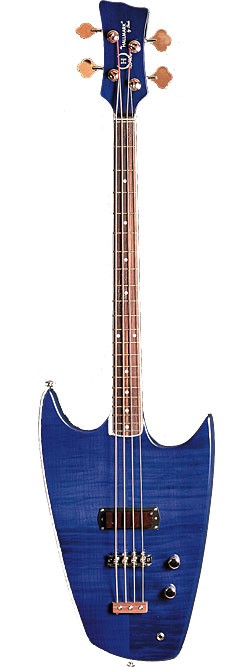
Hallmark Custom Series Swept-Wing in Transparent Blue. Photo by Willie G. Moseley.
As for the electronics and controls, Ridinger noted, “Our engineer, who used to work with Seymour Duncan, did a great job analyzing the lipstick-tube pickups from the ’50s, and coming up with a ‘new’ – meaning old – design that has really great tone. It is quite close to the sound of the originals.” The instruments, he added, have a master Tone, master Volume, and a three-way pickup switch. They may revisit the stacked tone and volume controls in the future.
Eastwood
Eastwood Guitars founder Mike Robinson is among those who take the “better than the original” approach.
“We pride ourselves in the look and feel of our replicas, without them being replicas at all,” he said. “I refer to our guitars as ‘tributes,’ because the goal is not to replicate the original. For the most part, the guitars we are ‘replicating’ were not that good in the first place. They looked good, they had great style, but they were never great players. Our goal is to meet the criteria of original look and style, but also to greatly improve the playability of the instrument, at an affordable price point.”
Eastwood offers numerous styles of guitars, basses, mandolins, baritone guitars, and resonator guitars, almost all of which have a connection to a classic brand and model. Each of its eight basses have a spiritual ancestor: the Club Bass is inspired by the Höfner Club; the EEB-1 and EUB-1 by ’60s Ampeg AUB; the Airline by Valco’s Airline series; Airline Map by National’s Valco-branded map-shaped instruments; Hi-Flyer by Univox’s Hi-Flyer; the Rocket by Eko’s Rokes; and the Classic 4 by Gretsch’s Country Gentleman guitar. All are short-scale, with the exception of the EEB-1 and EUB-1, which are full-scale (VG “Gear Reviews,” May ’08).
The Valco-inspired Airline models are intriguing in part because Eastwood now owns the Airline trademark and the early-’60s Res-O-Glas Airline two-pickup model has recently seen a surge in popularity thanks to Jack White, guitarist and front man for the White Stripes. Eastwood’s Valco basses differ from the originals in several ways, including having bodies made of chambered mahogany instead of Res-O-Glas, flush-mount pickguards (instead of elevated), and top binding instead of a center strip on the body (the original was a rubber grommet that attached the two Res-O-Glas body halves). “We polled customers to see whether they’d be willing to pay extra for the white strip down the middle – $100? $200? The answer came back loud and clear – zero!
“The Classic series is available in four-, six- and 12-string models,” he added. “All have the same body design, loosely reminiscent of the Beatles-era Gretsch Country Gentleman. These are semi-hollowbody guitars – maple top, back, and sides, with a center block. Our initial Classic 4 had a floating wooden bridge, true to the ’60s look and feel. However, a few customers complained about difficulty changing strings, then maneuvering the bridge to correct intonation. So it now has a fixed bridge; less than 100 were made using the floating bridge.”
The Airline Map bass is the company’s best-selling bass, with the EEB/EUB gaining ground.
Gibson
The legendary guitar company that began making stringed instruments more than a century ago does make faithful reissues of its most soughtafter vintage guitars. In 2005 it began offering a bass that may seem like a tribute but actually cops cosmetic and construction ideas from an even more desirable guitar from the ’50s.
The short-scale EB-3 was a two-pickup bass popularized in the ’60s by players such as Jack Bruce of Cream and Andy Fraser of Free. The new model was known as the SG Reissue Bass, and while purists might consider the application of “reissue” specious, its silhouette did match that of the EB-3 as well as that of the SG guitar, Gibson’s mainstay guitar in the ’60s.
The SG Reissue Bass still has one large humbucking pickup and one mini-humbucker like the EB-3, but its two Volume controls and master Tone control are simpler than those of its ’60s progenitor. Moreover, the bridge/tailpiece assembly is the improved three-point style first seen on ’70s Gibson such as the Ripper and RD Bass.
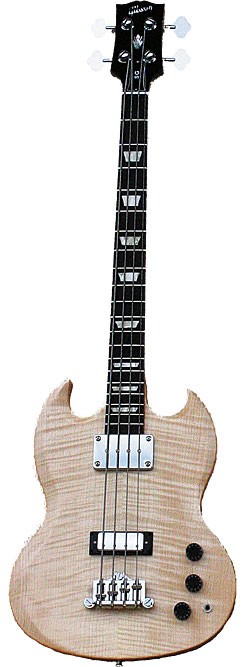
Gibson SG Supreme basses. Photo by Willie G. Moseley.
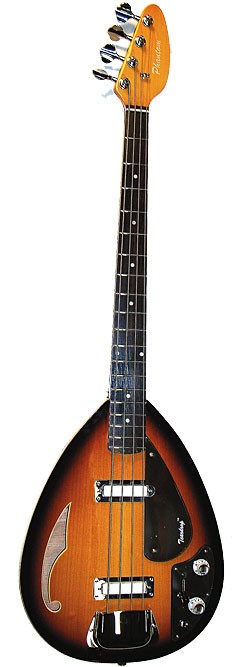
Phantom Teardrop hollow body in Tri-burst. Photo courtesy of PGW.
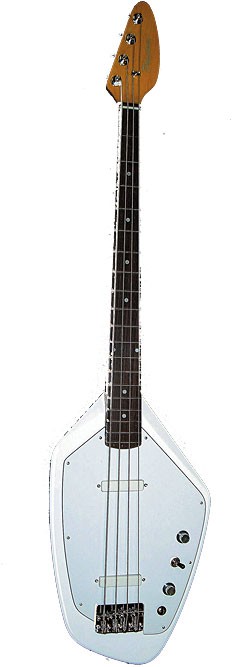
“Phantom IV” in White. Photo courtesy of PGW.
In 2007, Gibson launched its Guitar of the Week program, where it offers guitars and basses with unique woods, extra pickups, special finishes and/or hardware, etc. The very first instrument offered was the SG Supreme Bass, which while it retains the classic body shape, uses trapezoid fretboard markers instead of dots, and black “speed knobs” instead of the “top hat” knobs with silver inserts found on the SG Reissue. Its most eye-catching amenity is a flame-maple top that makes up half of the thickness of the body, the other half being mahogany.
Hallmark
Hallmark was among the names that emerged from the often-controversial Bakersfield (California) guitar-building scene of the mid 1960s. The brand was in business from ’65 to ’68, but barely got into production and showed instruments at just one NAMM show, in ’67. Its primary model was the Swept-Wing, which had a modernistic silhouette and was available in six-and 12-string configurations as a guitar and short-scale bass. An estimated 15 to 25 basses were built, mostly solidbodies, with one pickup. However, some solidbody Swept-Wing basses had two pickups, and a small number of hollowbody Swept-Wing basses may have been built.
A few years ago, Maryland luthier Bob Shade acquired the rights to the brand and the Swept-Wing design, and has been marketing “Hallmark by Shade” Swept-Wing instruments. Most are produced overseas using Hallmark’s own U.S.-made parts, but Shade and ex-Mosrite employee Bill Gruggett also handcraft certain models in their custom shop.
“From a visual standpoint, there’s the obvious ’60s sex appeal,” Shade said of his affection for the Swept-Wing design. “But equally important is that it’s very well balanced and offers a unique tone, as well as access to the upper frets.”
Production Swept-Wings are made in two configurations; the Vintage series is cosmetically faithful to its ’60s predecessors and has a zero fret, maple bolt-on neck that is 11/2″-wide at the nut, and wood tailpiece. It offers refinements such as improved string rollers in its silo-shaped bridge saddles. The upgrade Custom series has a figured maple top, set mahogany neck, and tortoiseshell pickup cover.
“With the popularity of some high-end guitars with set necks and decorative maple caps over mahogany, I thought it would be good to offer a model to expand and complement what was available from Hallmark in the ’60s,” said Shade. Basses in both series are short-scale, single-pickup models, and the Swept-Wing line uses neck binding.
Phantom
Phantom Guitar Works has been in the “retro” business since 1992, designing guitars, basses, and mandoguitars that offer a chronological and aesthetic nod to classic ’60s Vox instruments from England’s Jennings Musical Industries, which were made in Great Britain, and later, by Eko in Italy.
“I always thought they were cool,” PGW founder Jack Charles said of body styles like the Teardrop and Phantom. “But in their day, they were considered camp. I never even wanted to make a bass because many players felt like the original basses were horrible – very difficult to play.”
But Charles, who spent several years working at Jackson Guitars, had such affection for the look of oddly-shaped instruments that when he started his own guitar company he decided to create improved instruments that referenced old silhouettes. Those refinements include better woods and humbucking pickups (the originals were notoriously microphonic), and relocating pickups for improved sonic reproduction.
“I think JMI was one of the most innovative companies ever, and I wanted to approach this as, ‘What would (Tom) Jennings be doing now?'” Charles enthused. “I can guarantee you he wouldn’t be making them the way they were made in ’65. I’m sort of caught in an awkward place, because the everybody in the States is acquainted with the Italian guitars, but I’m inspired more by the original English versions, which are quite rare.”
Charles keeps his line limited to three basses – the Phantom IV, a solidbody Teardrop, and a semi-hollow Teardrop. The latter, which has a single f-hole, was inspired by the Bill Wyman model from the ’60s, which was the only signature Vox instrument from that era.
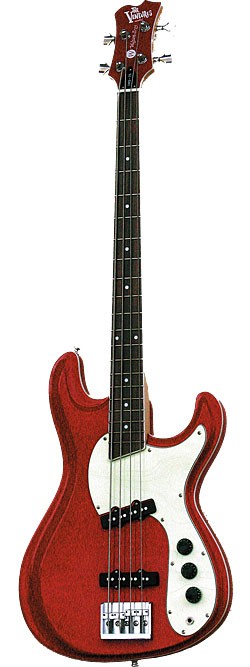
Wilson Bros. VMB-75 in Candy Apple Red. Photo by Willie G. Moseley.
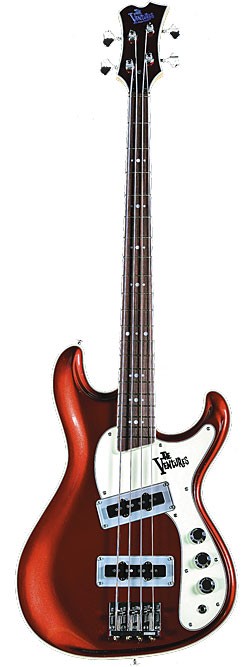
Wilson Bros. VCMB-2001 in Candy Apple Red. Photo by Willie G. Moseley. Silver surrounds
All PGW basses have maple necks with rosewood fingerboards. The Phantom IV and the Teardrop solidbody have mahogany bodies, while the Teardrop semi-hollow has an arched maple top as well as maple sides and back. A wood center block runs from the neck to a termination point just past the bridge. All three have a 32.5″ scale.
“Phil Volk (of Paul Revere & the Raiders) put a Fender neck on his Phantom IV bass a long time ago,” he noted. “But that bass will not balance with a 34″ scale, even if you used a piece of heavy ash for the body. I tried! But I felt I couldn’t make or market a bass that had to be held up by the neck when played, which was the design problem back then. I wasn’t going to copy that. So I used the Bill Wyman headstock shape, and combined with the slightly-shorter scale, it makes for a balanced bass. And the 32.5″ scale is the reason the pickups and the bridge are in different locations compared to the original.”
Wilson Bros.
One of the more unique ventures (pun intended) in the retro-guitar/bass market was founded in 2002, though one of the principles was crafting guitar-based music for more than four decades beforehand.
Under the aegis of Ventures founding guitarist Don Wilson, his son, Tim, and James Fox, the Wilson Bros. line offers what the younger Wilson terms a “hybrid” of the best features of other brands associated with the Ventures, including Fender, Mosrite, and Aria.
“We wanted to come up with a line that we designed, not simply something we endorsed,” Don Wilson said, noting that the brand does indeed reference classic aesthetic and sonic facets associated with the Ventures.
There are five basses in the Wilson Bros. lineup, all 20-fret, bolt-neck models with a 34″ scale.
The entry-level VPB-30 is a generic, P-Bass-style. But the rest use a body silhouette more associated with the Ventures. Their development came from Ventures bassist Bob Bogle, as well as “fifth Venture” Bob Spalding (VG, March ’08), and while the body evokes a Mosrite vibe, the cutaway horn on the bass side is still longer, a la Fender. Other common turf includes two single-coil pickups – the neck unit being angled in another Mosrite reference, parallel to the offset end of the fretboard – two Volume controls and a master Tone control.
The VMB-55 has the standard layout for the trademark models, but a relatively plain body. The VMB-75, though, has the fabled “German carve” seen on Mosrites. And while all trademark-body models have bound necks, the VMB-75 has binding on the upper edge of the body. The pickguard is a three-layer “mint green color – the only pickguard that is a different (but historically appropriate) color. The fretboard is flat, and has a semi-gloss finish. Finally, the VMB-75 has an upgraded bridge/tailpiece.
The VMB-100 adds a zero fret, brass nut, upgrade Duncan Design pickups, multiple-layer binding, and upgrade control knobs. The ultimate Wilson Bros. bass is the VCMB-2001, handcrafted in Aria’s Custom Shop in Japan (the Ventures endorse Aria in Japan, therefore Wilson Bros. instruments are not sold there), with Seymour Duncan/Bassline SJB-2 pickups, fancier fretboard inlay, and a bone nut.
As more guitar/bass builders and distributors jump aboard the retro bandwagon, the panache of time-warp instruments like these should equate to more styles from the past to choose from in the future.
This article originally appeared in VG‘s August 2008 issue. All copyrights are by the author and Vintage Guitar magazine. Unauthorized replication or use is strictly prohibited.



